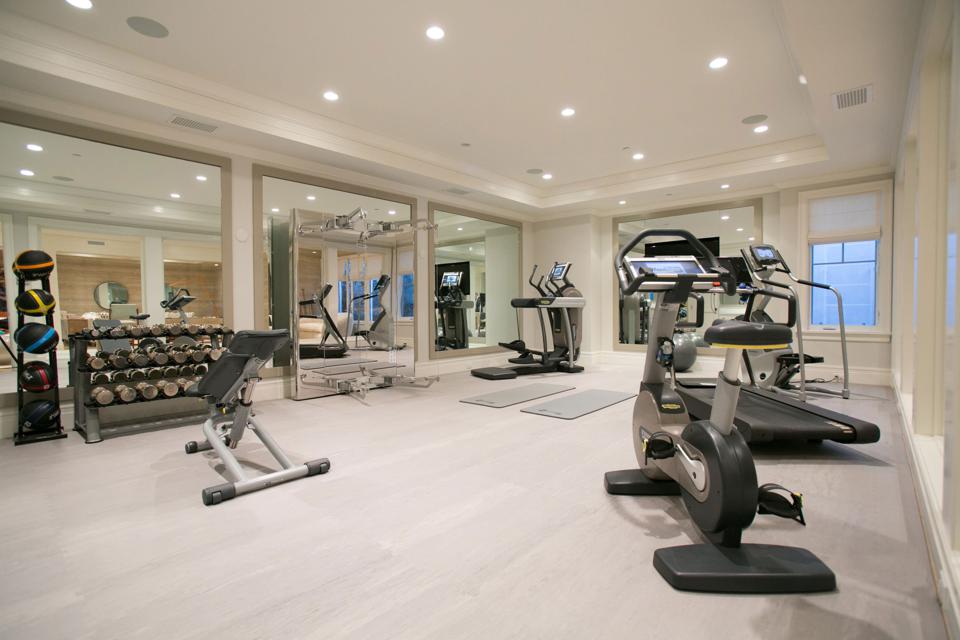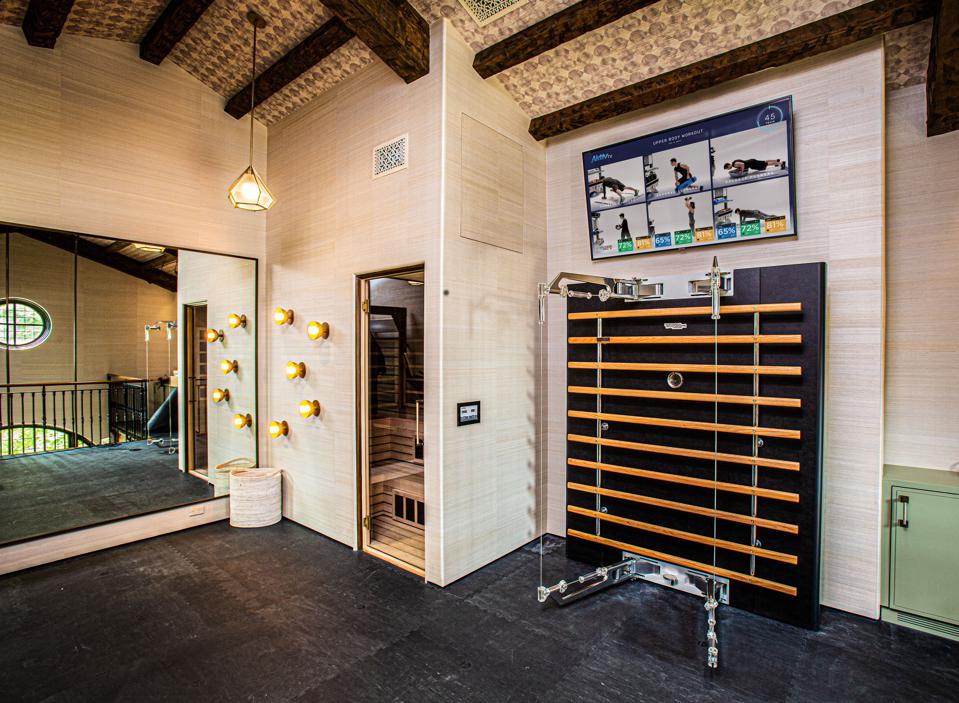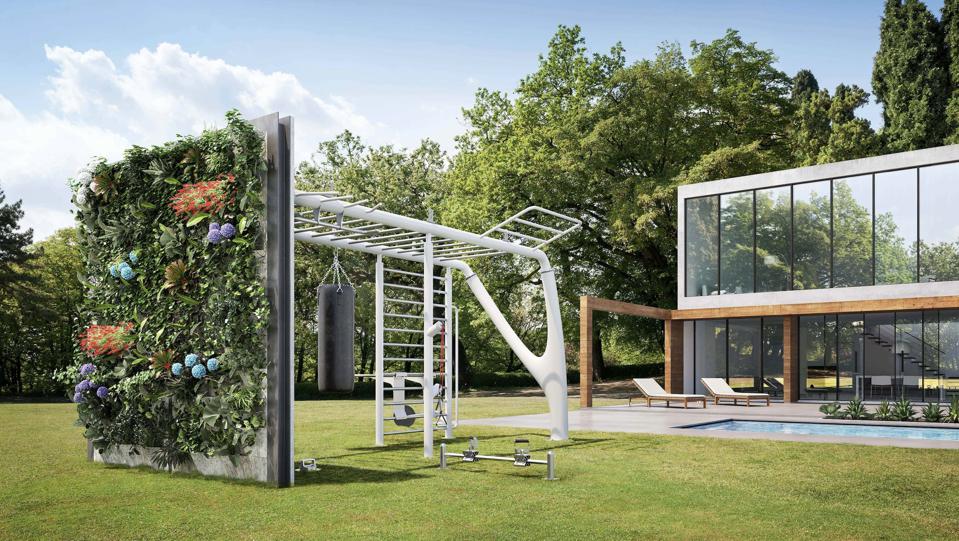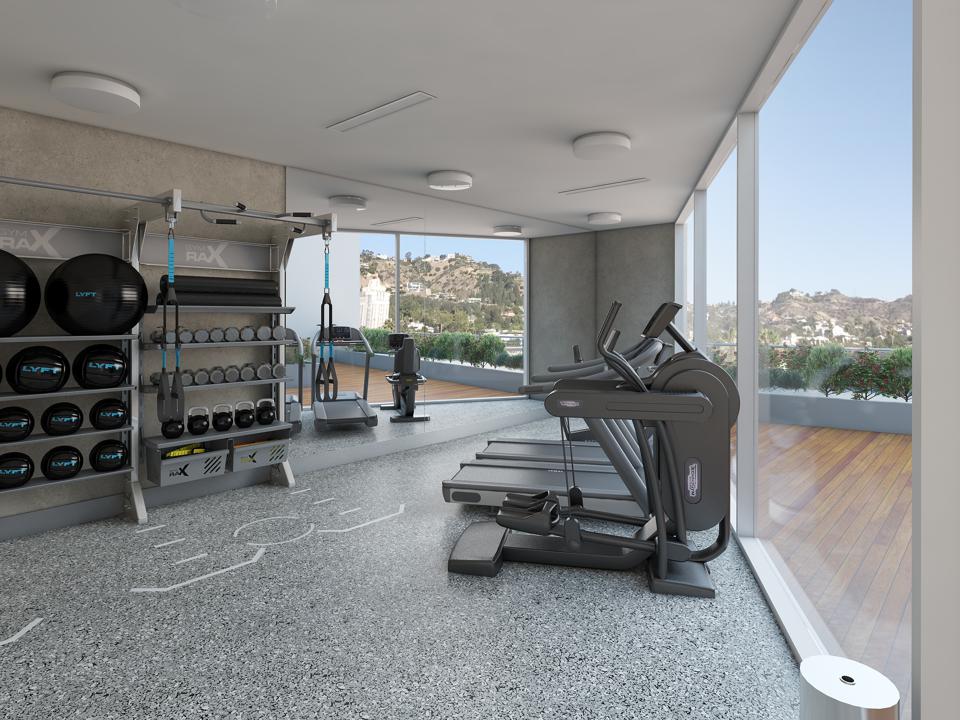
A home gym overlooking a gorgeous view.
FitnessDesignGroup
The Covid-19 pandemic has forced us to shift how we interact with the world, from shopping at the grocery store to spending time with family and friends to the establishments we frequent, be it a restaurant or a gym. The world is starting to open but with no vaccine and public regulations still in place, like wearing a mask, social distancing and reducing indoor capacity, it’s unsettling for most to dive back into daily life. This includes exercising at the once-beloved indoor gym.
As offices remain closed and many schools are shut in lieu of virtual learning, we’re spending more time than ever in our homes. Home workouts via fitness apps, YouTube videos or virtual subscriptions are skyrocketing but many aren’t used to working out at home. Where to begin? For the luxury market, the answer is creating a gym from scratch or transforming an existing room into a workout haven. A home gym is a wonderful investment to stay fit and healthy during these unprecedented times.
Here are three companies whose gym designs are not only functional, but beautiful.
Scavolini
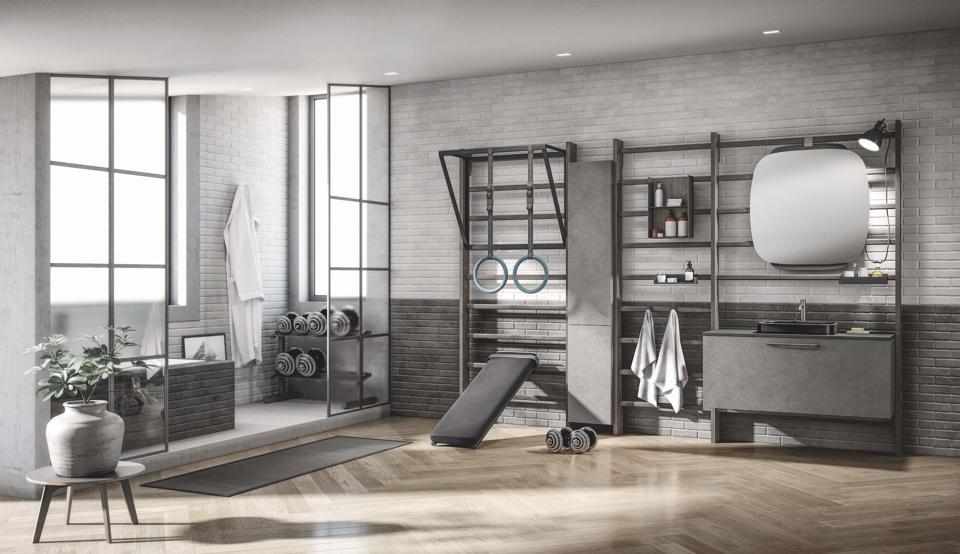
Gym Space Project features gym equipment alongside bathroom amenities.
Scavolini
Italian kitchen, living and bathroom design company Scavolini saw the interest in creating a home gym even prior to the pandemic with the launch of its Gym Space Project. Today, it’s more apt than ever. Gym Space Project is a modernly designed gym concept that fits seamlessly into a bathroom, living room or laundry room.
Daniele Busca, Scavolini USA’s creative director and brand ambassador, says the company has seen an increase in inquiries for home gyms, especially following the Covid-19 outbreak. It’s no question that when gyms closed, many were left with limited exercise options and were quickly scrambling to find space and equipment that allowed them to stay fit while in quarantine.
“The initial concept was inspired by the matter of space,” Busca says. “For many people, having a dedicated room in your home for a home gym is not feasible, so the project was aimed to provide an accessible option for a home gym. Incorporating it into the bathroom made sense.”
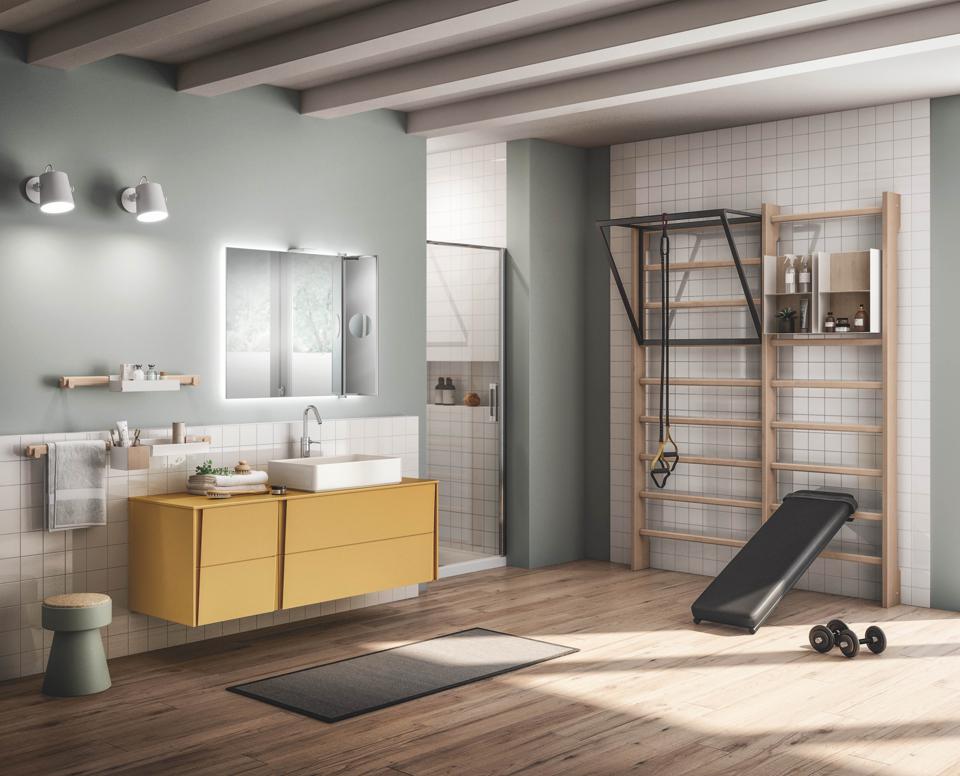
A colorful interpretation of the Gym Space Project, featuring the gymnastics wall bar, a bench and … [+] weights.
Scavolini
Scavolini was inspired by Italy’s heritage, and specifically, ancient Rome.
“[We] looked back to ancient Rome, where baths were monumental buildings and cathedrals of wellness, and the use of steam rooms and hot and cold water became a science,” Busca says. “This idea of mens sana in corpore sano, which translates to “a healthy mind in a healthy body,” will permeate future bathroom trends, with designated areas for fitness that incorporate Pilates, cardio or gymnastic equipment.”
The system, designed by Mattia Pareschi, reconfigures a typical bathroom set up and combines bathroom furnishings with exercise equipment. The entire range revolves around one classic piece of equipment: a gymnastics wall bar. Not only is it a design element, but attached to the wall bar is a lifting bench, traction bar and pull-up rings, plus bathroom storage, hangers, a sink, lighting and mirrors. It’s functional for both the bathroom and the gym, while simultaneously looking like a minimalist and modern piece of decor.
However, people can customize any aspect of their home gym, be it their kitchen, living room or laundry room, and customizations also extend to the color scheme and configuration. All the products used are also certified for ultra-low emission levels in relation to formaldehyde and VOC, and use Idroleb Ecological Panels from recycled wood. No matter which customization is chosen, the furnishings err on the contemporary side.
FitnessDesignGroup
A bright and airy home gym in Los Angeles.
FitnessDesignGroup
Scavolini isn’t the only player in home gym design. Whether it’s a Fifth Avenue penthouse or a sprawling California estate, FitnessDesignGroup (FDG), founded in 2005, has options that make a gym a natural part of a home’s design. The Los Angeles-based firm has designed gyms in multiple office locations for Apple, Nike, Starbucks, Snapchat, Google and the Los Angeles Lakers and has created fitness centers and tailored in-room fitness amenities for hotel corporations including Hilton and Accor. The company is seeing an immense increase in inquiries for residential projects all over the U.S.
Working across the world, New York, Los Angeles and San Francisco are the largest markets, with many requesting gyms for their second homes in Idaho or Montana. Historically, the bulk of FDG’s residential business comes from new homes but since the Covid-19 pandemic struck, it’s been a lot of conversions.
A loft gym at a residence in the Pacific Palisades in California.
FitnessDesignGroup
“Although the trend towards identifying more intentional and dedicated space for exercise at home has been steadily increasing for years, during Covid-19, consumers have widely clamored to buy up small accessories and any dumbbell or kettlebell they can find,” says Bryan Green, founder and CEO of FitnessDesignGroup. “However, more thoughtfully, we’ve experienced a massive uptick in clients who are interested in taking a holistic approach to creating permanent wellness space within their homes. Our home gym design division has been inundated with helping plan a next generation of really special spaces.”
Technology takes center stage in this “next generation” of home gyms, whether someone enjoys watching a show or the news while on a treadmill, playing music or following along to an online workout.
“The overwhelming majority of content distribution right now is being played through YouTube and through Zoom and other sources where people are utilizing their own devices and then looking to integrate those in or around in proximity to where they’re training,” Green says. “We’re putting in smart TVs, which are web-enabled, and we’re doing a lot of that integration into these wall systems.”
A rendering of a chic outdoor home gym, complete with a living wall.
FitnessDesignGroup
In terms of design, Green says that people want a gym that fits in with the rest of their homes. While some may like the black, rubber flooring found in more commercial gyms and health clubs, many want a chic space that incorporates materials used in the rest of their house. He says: “We have a myriad of colors and options to work with today that can really open up the space, both functionality and aesthetically,” he says. “As a general rule, people like light, bright, energy-stimulating palettes that make for an uplifting space for fitness.”
HIIT workouts, yoga or boxing require open space for movement, and many want to open up the interior of the space and put the machines and equipment along the perimeter. They can accommodate any type of gym, including training equipment for a specific sport if necessary. While equipment depends on the client’s budget and workout preferences, FDG installs every type of equipment, like Peloton, Mirror, TechnoGym, Hyperice or GymRax. They also create creative outdoor gym spaces, like an adult playground, with pull-up bars, punching bags and climbing bars.
Contrary to what one might think, all someone needs is an area as small as 6’x8’, according to Green. “We have a lot of clients that sometimes just have small apartments and want to identify a reasonable, smart system for training. And it can be done,” Green says.
PENT Fitness
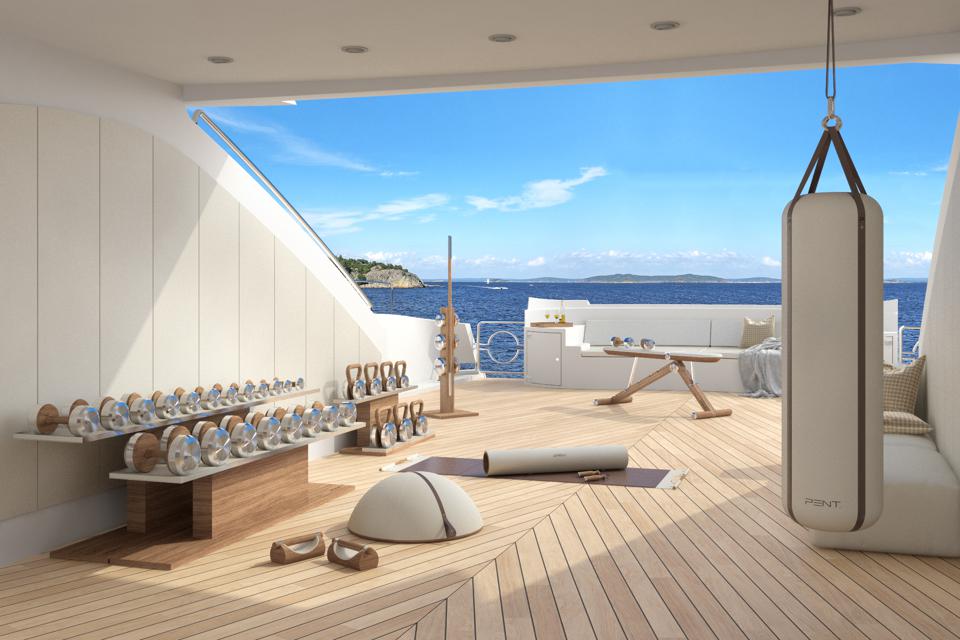
A gym aboard a yacht, featuring teak, stainless steel and white leather.
PENT Fitness
Fashion aficionados might be more drawn to Polish company PENT Fitness, founded in 2012, which creates custom luxury gyms for residences, hotels and yachts. PENT creates custom gyms using rich materials like wood, steel, leather, bronze and more. In addition to gym creation, PENT has a line of products including dumbbells, kettlebells, a weight bench, weighted balls, wall bars and more. It has a wide range of products under two color schemes: gold and silver. The gold collection features real bronze and bog oak, or black oak, and they can also laser engrave logos, signatures, or family names onto any products. At first glance, PENT Fitness’ products look like expensive decor, not functional workout equipment – and that’s exactly what the company was going for.
“Our products look like beautiful furniture, and we’re offering our clients something that wasn’t offered before,” says Marcin Raczek, CEO and founder of PENT Fitness.
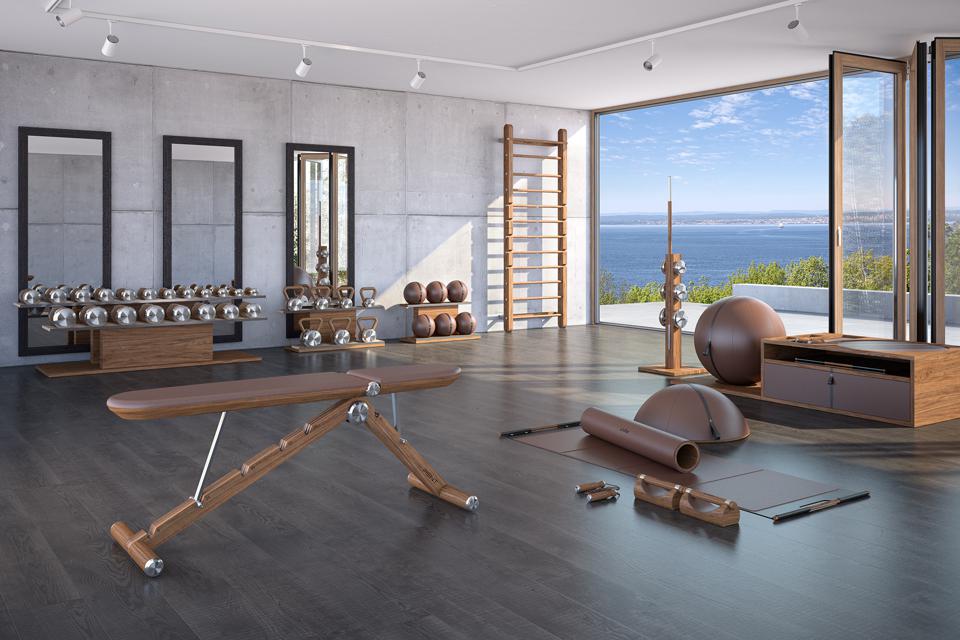
A home gym featuring PENT Fitness’ Silver collection of workout equipment.
PENT Fitness
All its products are produced in-house in Poland and materials are sourced from around Europe. Many of the pieces are hand-made and hand-assembled, which is unique for this market.
“We have our own wood, steel and upholstery production,” Raczek says, adding that PENT’s pieces aren’t mass produced as the company believes “real luxury products should be limited.”
The U.S., specifically New York, Miami and Los Angeles, is PENT’s largest market with Australia and Dubai falling closely behind. Standard pricing for a custom gym by PENT can range from $27,000 to $40,000 and beyond, depending on the level of customizations.
“We’re seeing a new trend in designing where new builds have already designed a space for the home gym,” he says. “I think this will soon become the standard.”
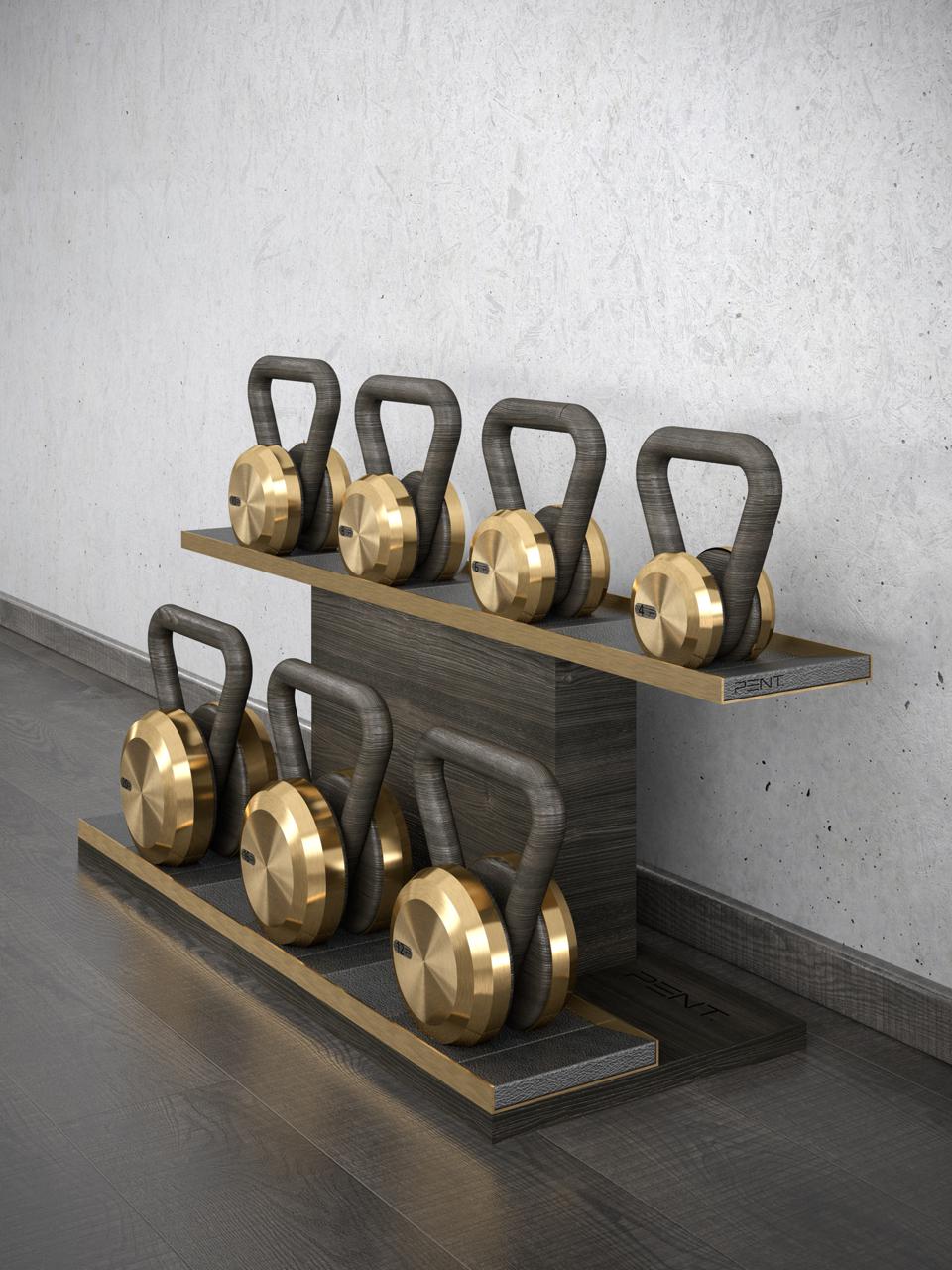
PENT’s LOVA kettlebells made with bog oak and bronze.
PENT Fitness
PENT works closely with architects to create a gym that looks like a work of art. Each type of project, where it’s a home or a yacht, requires a thoughtful approach. For example, yacht gyms must include rust-resistant materials, like teak, stainless steel and white leather, which gives a brighter feel and won’t be as likely to fade over time. These gyms encourage people to exercise when they are in a beautiful space, though it’s hard to imagine a more appealing workout destination than on a yacht overlooking the Mediterranean Sea.
